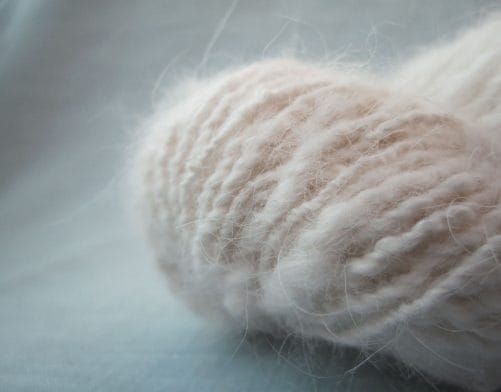
As some of you know, I live with a delightful little (well, fairly large) angora rabbit named Linus. He was the little spokes-bunny for our Special Reserve Sugarbunny line when I first started working here and periodically comes to work with me here at the office! Every three months I give him a big shave and wind up with about 2-3 ounces of useable fiber. I’ve had several years to practice spinning angora fiber and have figured out a few things about this specific fiber type that I thought I’d share today! In the photo above, the top two skeins are 100% angora from different shearings and the bottom skein is 80% hand processed wool and 20% angora.

Linus’ average fiber staple length is about 2.5 inches, which isn’t particularly long. Combine that with the slippery nature of angora fibers and you get a very tricky project to try on a spinning wheel. I’ve decided to avoid the wheel entirely and use a drop spindle to process all of his gorgeous fiber. I have a lot more control over the twist with a spindle and it’s easy to put the whole project down when I get bored or frustrated as opposed to taking up an entire bobbin on a spinning wheel. I’ve also found that I very much prefer working with a Turkish Drop Spindle because I’m able to make a center-pull ball without having to rewind the twisty singles on a ball winder. It’s so easy to just slip the arms off the center spindle and out of the yarn ball. Then I simply ply the two ends of the same length of yarn together to get my two or three-ply yarn!
I have tried to spin his fiber on the wheel, but I made the whole process much easier by blending it with some wool that I had processed the summer before. That left me with a delightful blend with the soft characteristics of angora and the long staple-length of the wool to hold things together better. I’ve been thinking about experimenting with dying an angora/wool blend this summer using the Earthues Botanical Dye Kit to see how the two fibers take the dye after they’ve been spun. I’ll be sure to share those results with you when the weather gets warm enough to do some batches in the back yard!
In the meantime, if you want to brush up on your drop spindling skills, or want to learn I would definitely recommend browsing through Kelley’s Drop Spindling Class on our website. Kelley walks you through each step of the process from putting the spindle together to plying. I noticed that I needed a little refresher on how to wind the yarn around the arms when I picked up my spindle last time so I watched the Park and Draft Part One video for a little reminder.



